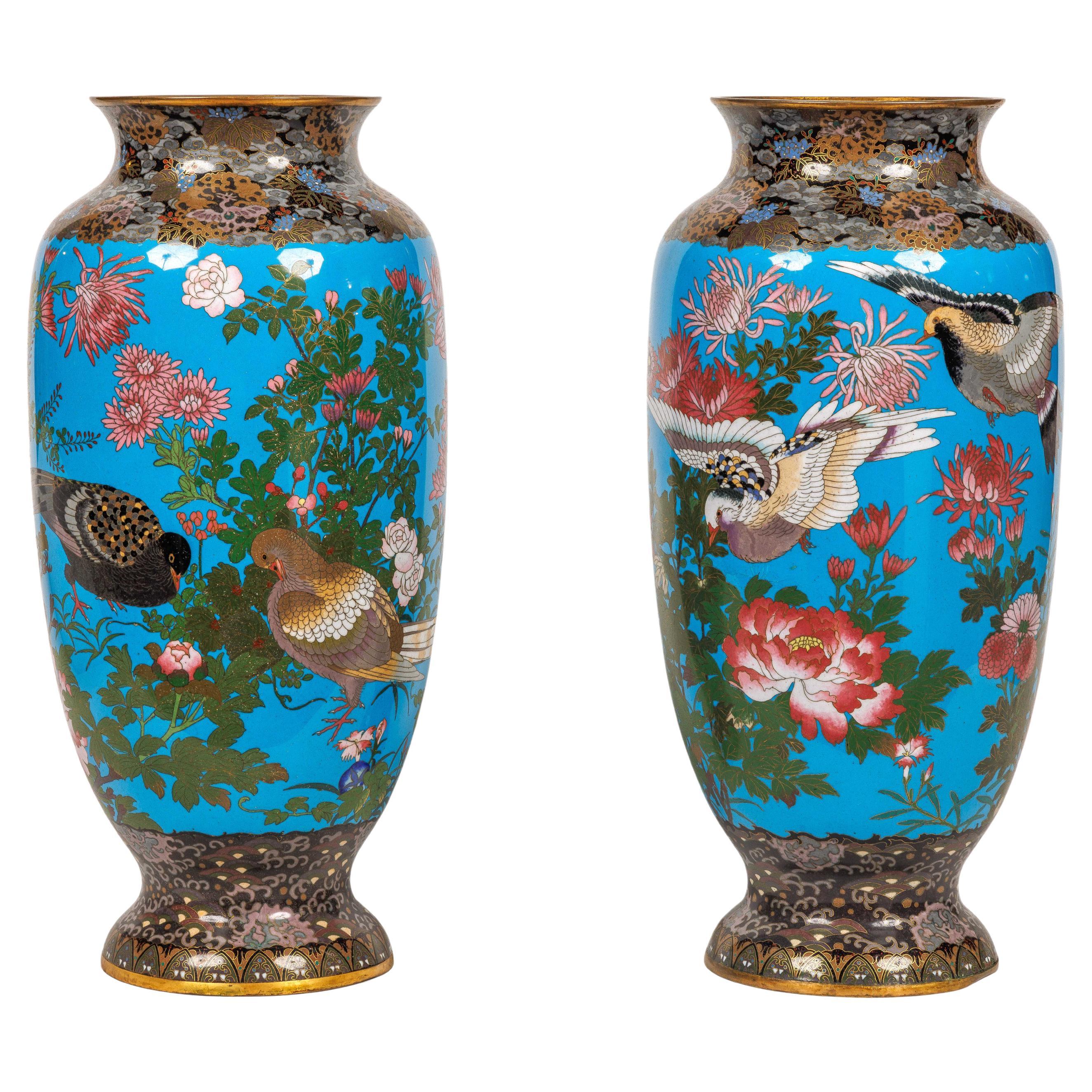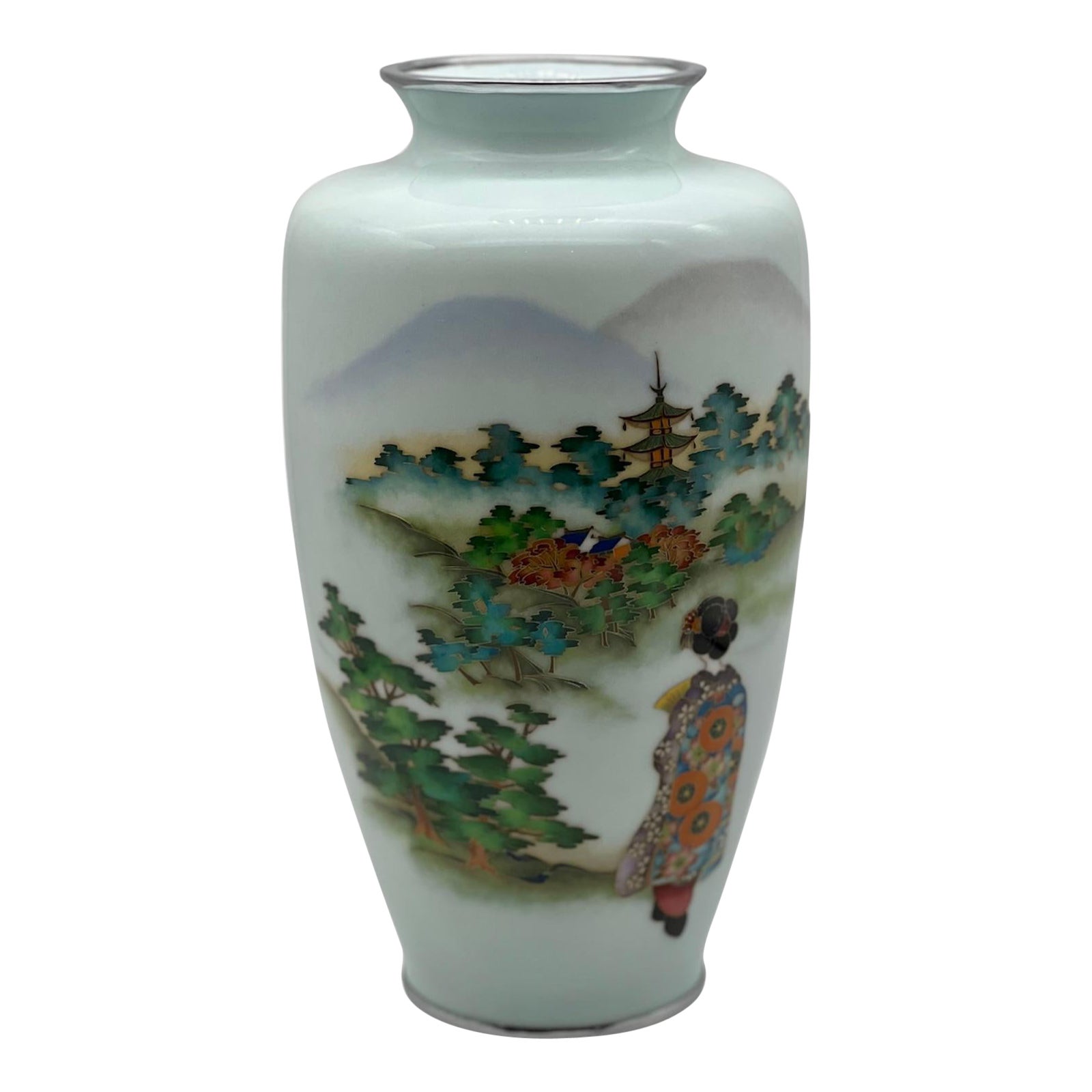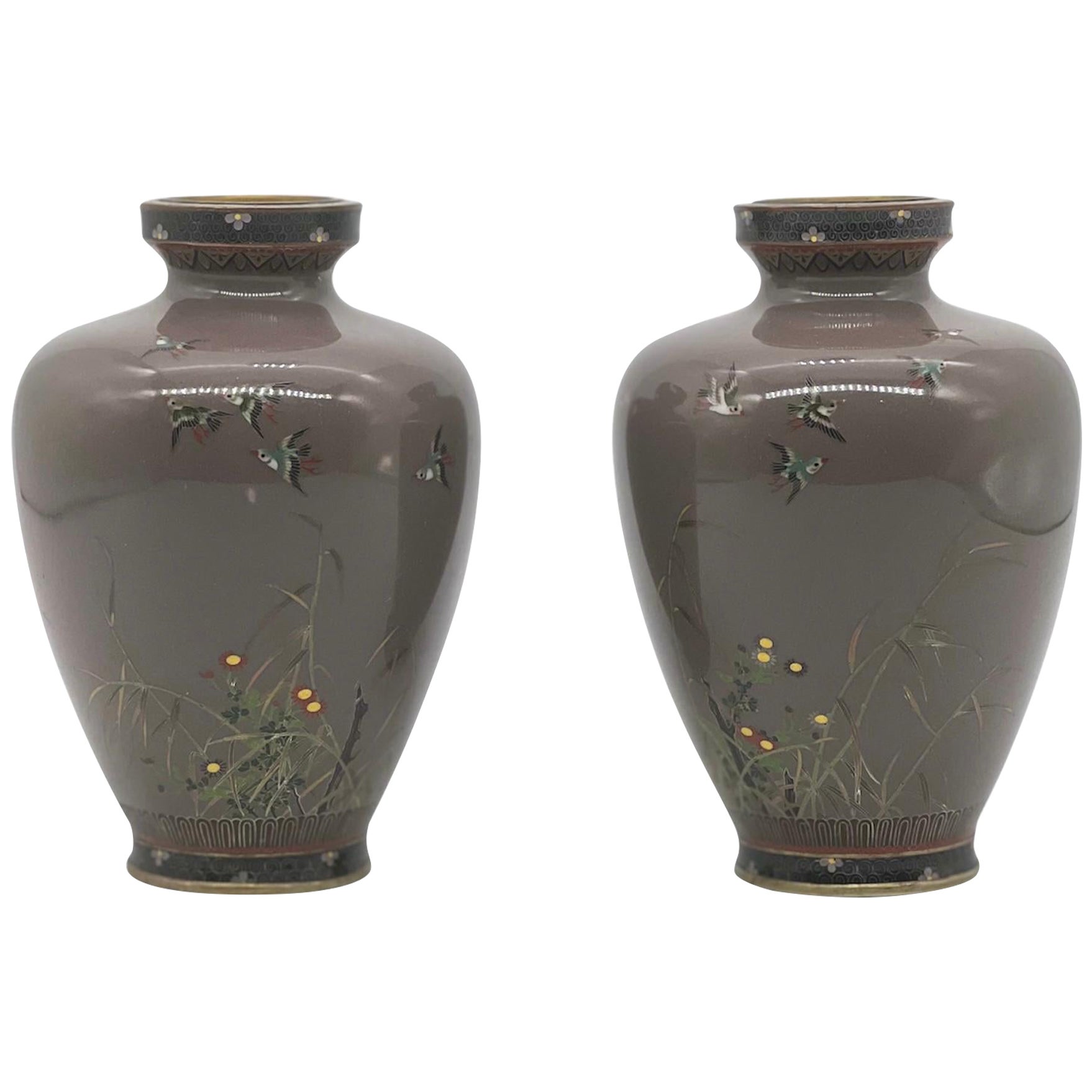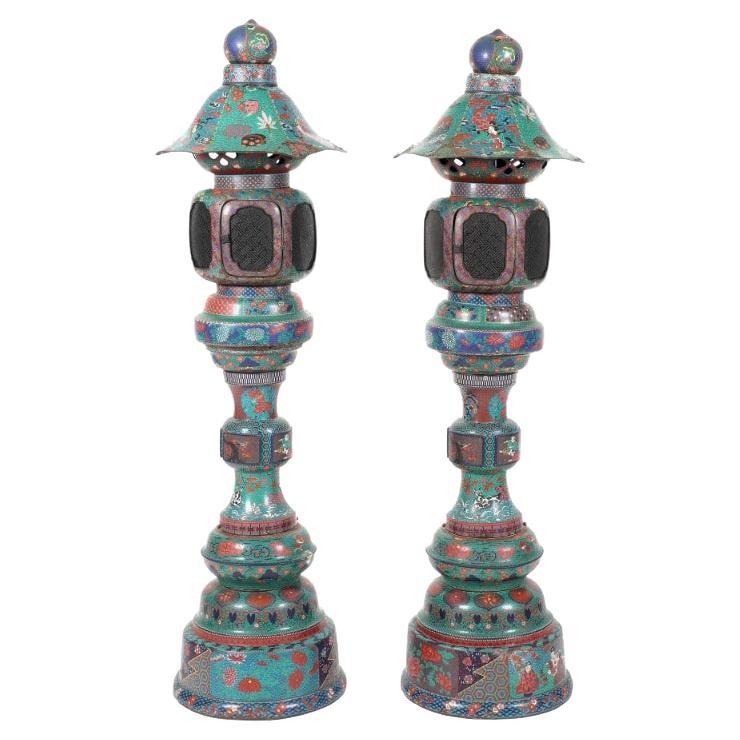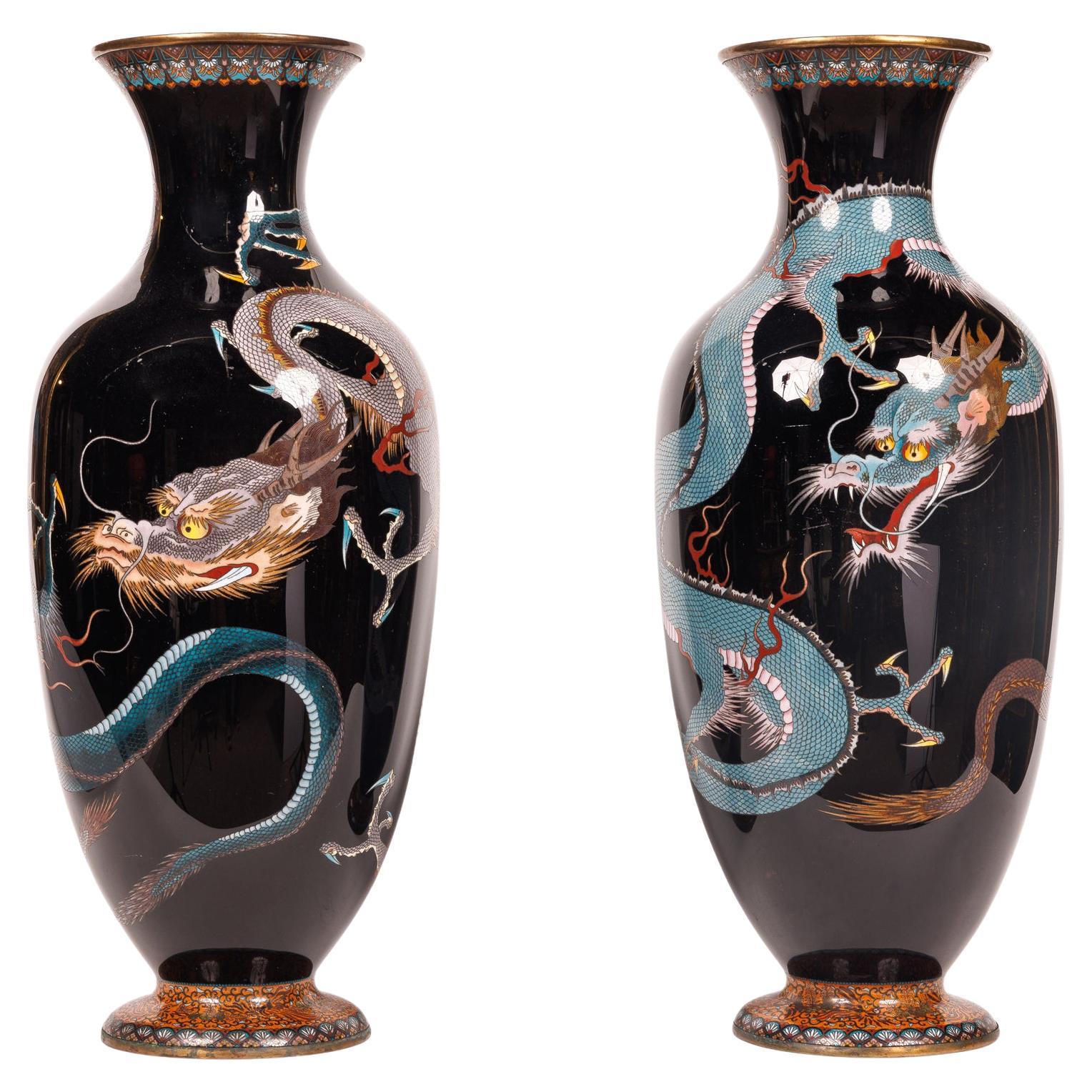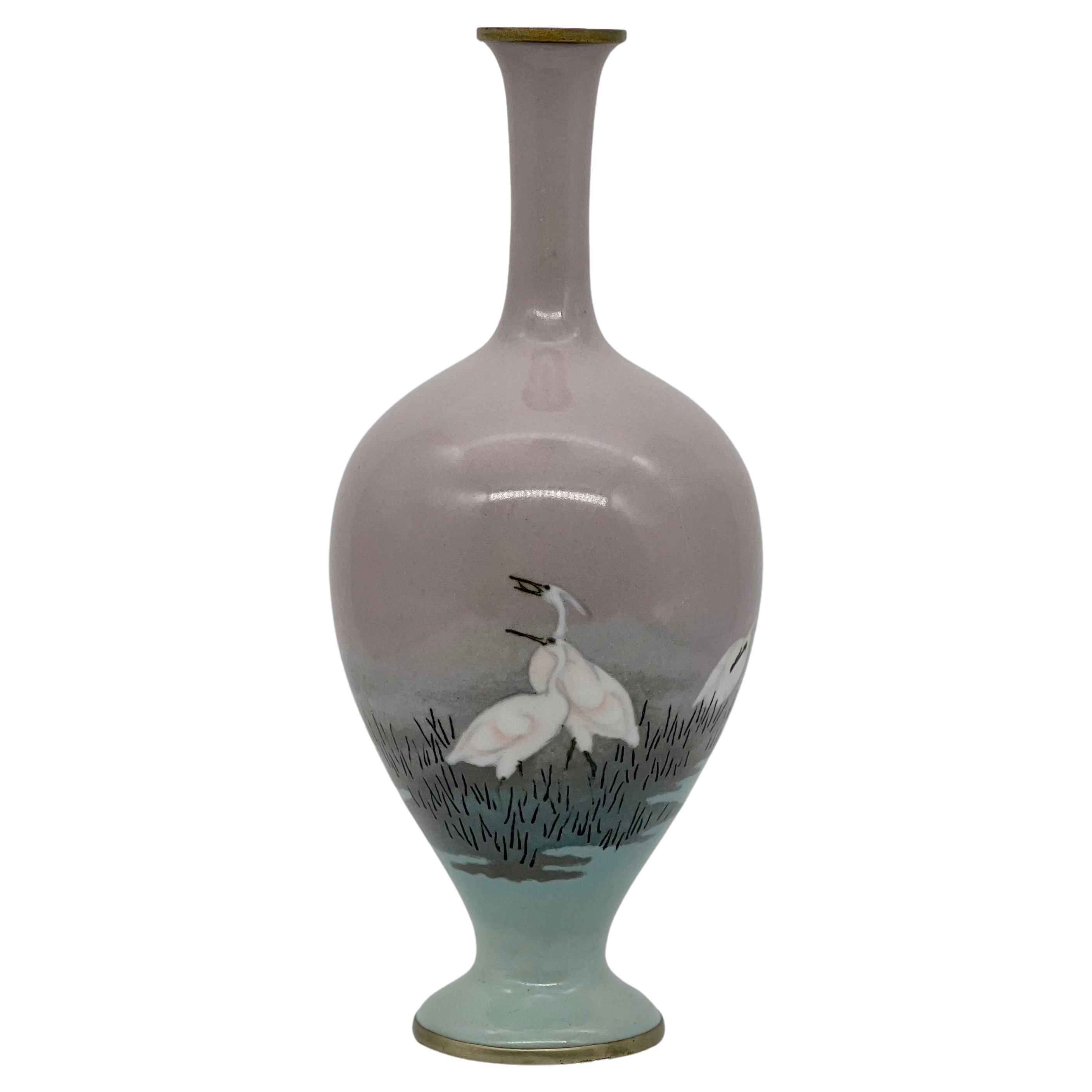Items Similar to Large Pair of Japanese Cloisonne Enamel Vases Attributed to Honda Yasaburo
Want more images or videos?
Request additional images or videos from the seller
1 of 21
Large Pair of Japanese Cloisonne Enamel Vases Attributed to Honda Yasaburo
About the Item
A large pair of Japanese Cloisonne Enamel vases attributed to Honda Yasaburo, 19th century.
Finley decorated with the rich enamel colors of orange and green, these vases are designed with birds, phoenix, dragons, lotus and paulownia flowers and the traditional Japanese Karakusa pattern.
Karakusa is a decorative motif commonly used in traditional Japanese art and design. The word "karakusa" refers to a type of plant, often translated as "Arabesque" in English, which features a twisting and curling vine-like stem with leaves and flowers.
The karakusa pattern is created by repeating this vine-like stem in a continuous pattern, often with various other elements such as flowers, fruits, and leaves. The pattern can be found in a variety of mediums, including textiles, ceramics, and lacquerware.
The karakusa pattern has a long history in Japanese art and design, dating back to the Heian period. It was often used as a decorative element in clothing, such as the kimono, and in architecture, such as in the decorative elements of temples and shrines.
Today, the karakusa pattern is still a popular decorative element in Japanese art and design. It is often used in modern designs for textiles, stationery, and other decorative items. The pattern has also been adapted and incorporated into contemporary Western designs, often used in fashion, home decor, and graphic design.
Honda Yasaburo was a renowned Japanese cloisonne artist who lived and worked during the Meiji period (1868-1912) in Japan. He was born in 1845 in Nagoya, Japan, and studied under the famous cloisonne artist Namikawa Yasuyuki.
He was known for his exceptional skill and attention to detail in cloisonne enamel work, and his pieces are highly sought after by collectors today. His works often featured intricate designs with bold colors and gold accents, and he was particularly skilled at creating realistic depictions of animals, birds, and flowers.
Honda Yasaburo's works were exhibited in international expositions, including the Paris Exposition Universelle in 1900, where he won a Gold Medal for his cloisonne enamel vase. He was also awarded the prestigious title of "Teishitsu Gigei-in" (Imperial Household Artist in 1910 by Emperor Meiji.) in 1910 by Emperor Meiji.
Today, Honda Yasaburo's works can be found in major museums and private collections around the world. They represent not only exceptional artistry but also the cultural and historical significance of the Meiji period in Japan.
Measures: 19.5" high x 12" wide.
In overall very good condition, no damages noted.
- Dimensions:Height: 19.5 in (49.53 cm)Diameter: 12 in (30.48 cm)
- Style:Meiji (Of the Period)
- Materials and Techniques:
- Place of Origin:
- Period:
- Date of Manufacture:19th Century
- Condition:Wear consistent with age and use.
- Seller Location:New York, NY
- Reference Number:1stDibs: LU1798233535212
About the Seller
5.0
Vetted Seller
These experienced sellers undergo a comprehensive evaluation by our team of in-house experts.
Established in 1980
1stDibs seller since 2016
58 sales on 1stDibs
Typical response time: <1 hour
- ShippingRetrieving quote...Ships From: New York, NY
- Return PolicyThis item cannot be returned.
More From This SellerView All
- Large Pair of Meiji Period Japanese Cloisonne Enamel Vases Attributed to GotoLocated in New York, NYA large pair of Meiji Period Japanese cloisonne enamel vases attributed to Goto Seizaburo, 19th century. These vases were made during the Meiji period (1868-1912) in Japan and are...Category
Antique 19th Century Japanese Meiji Metalwork
MaterialsCopper, Enamel
- Large Pair of Japanese Cloisonne Enamel Lanterns Attributed to Kaji TsunekichiLocated in New York, NYA Large Pair of Japanese Cloisonne Enamel Lanterns Attributed to Kaji Tsunekichi, Edo Period, 19th century Japanese cloisonne lanterns were made during the Meiji period, from the late 19th to early 20th century, and were often used as decorative lighting fixtures in temples and shrines. Kaji Tsunekichi (1866-1916) was a Japanese cloisonné artist who was active in the late 19th and early 20th centuries. He was born in Tokyo and learned the art of cloisonné from his father, Kaji Sataro, who was also a cloisonné artist. He was renowned for his mastery of the shippo-yaki technique, which involves creating intricate designs with thin wires on a metal base before filling in the spaces with enamel. Tsunekichi was known for his exceptional technical skills and his ability to create intricate designs with vibrant colors. His works often featured nature motifs, such as flowers, birds, and fish, which were rendered in a highly detailed and naturalistic style. He also experimented with new techniques, such as plique-à-jour, a type of cloisonné that creates a stained-glass effect. Tsunekichi's works were highly prized during his lifetime and continue to be sought after by collectors today. He won numerous awards for his cloisonné creations, including a Gold Medal at the 1900 Exposition Universelle in Paris. His works are characterized by their fine wirework, precise enamel application, and attention to detail. Some of Tsunekichi's most famous works include a pair of large cloisonné vases...Category
Antique 19th Century Japanese Edo Metalwork
MaterialsCopper, Enamel
- Large Pair of Meiji Period Japanese Cloisonne Enamel Double Dragon VasesLocated in New York, NYA large pair of Meiji Period Japanese Cloisonne Enamel Double Dragon Vases, 19th century. Japanese cloisonne enamel dragon vases are highly ...Category
Antique 19th Century Japanese Meiji Metalwork
MaterialsCopper, Enamel
- An Exquisite Pair Of Japanese Cloisonné Enamel Vases with Chrysanthemum BlossomsLocated in New York, NYAn Exquisite Pair Of Japanese Cloisonné Enamel Vases with Chrysanthemum Blossoms, Attributed to Hayashi, Meiji Period. Experience the exquisite craftsmanship of the Meiji period wit...Category
Antique 19th Century Japanese Meiji Metalwork
MaterialsEnamel
- A Monumental Japanese Cloisonne Enamel Vase, Attributed to Hayashi KodenjiLocated in New York, NYA Monumental Japanese Cloisonne Enamel Vase, Attributed to Hayashi Kodenji "A Meiji Masterpiece" Behold the epitome of Meiji-era craftsmanship with this monumental silver wire Ja...Category
Antique 19th Century Japanese Meiji Vases
MaterialsEnamel
- Large Meiji Period Japanese Cloisonne Enamel Vase Adorned with Iris BlossomsLocated in New York, NYIntroducing a magnificent Large Meiji Period Japanese Cloisonné Enamel Vase adorned with enchanting iris blossoms. This extraordinary vase encapsulates the essence of Japanese artist...Category
Antique 19th Century Japanese Meiji Vases
MaterialsEnamel
You May Also Like
- A Large Japanese Cloisonne Enamel vase attributed to Ando JubeiBy Ando JubeiLocated in London, GBA Large Japanese Cloisonne Enamel vase attributed to Ando Jubei. Taisho period (1912 – 1926) A large baluster Cloisonne-Enamel vase worked in musen and silver wire of varying gauge...Category
Early 20th Century Japanese Metalwork
MaterialsEnamel
- A Fine Pair of Japanese Cloisonne Enamel Vases Attributed to Hayashi KodenjiLocated in London, GBA Exquisite Pair of Japanese Cloisonne Enamel Vases Attributed to Hayashi Kodenji. Meiji period 19th Century A Fine Pair of Japanese cloisonné ename...Category
Antique Late 19th Century Japanese Metalwork
MaterialsEnamel
- Fine Japanese Cloisonné-enamel and Musen Vase Attributed to Namikawa SosukeLocated in London, GBA magnificent Cloisonné-enamel and Musen Baluster vase attributed to Namikawa Sosuke. Meiji era (1868-1912), late 19th century. This vase features an elegant classic form with a sle...Category
Antique Late 19th Century Japanese Metalwork
MaterialsEnamel
- Japanese Cloisonne Enamel Vase Ando CompanyBy Ando JubeiLocated in Newark, EnglandJapanese cloisonne enamel vase. The vase of ovoid form with circular opening, black enamel glaze and silver mounted rims. Boldly decorated with autumnal flowers and birds. To the top and bottom geometric patterns finish the vase. Notes Ando Cloisonné...Category
Early 20th Century Japanese Meiji Metalwork
MaterialsMetal, Silver, Enamel
- A Fine Pair Pair of Japanese Cloisonne Enamel Oviform Vases. Meiji period.Located in London, GBA Magnificent Pair of Japanese Cloisonne Enamel Oviform Vases 19th Century Meiji period A Pair of Japanese cloisonné enamel oviform vases worked with silver wire and decorated wit...Category
Antique Late 19th Century Japanese Metalwork
MaterialsEnamel
- A Fine Opposing Pair of Japanese Cloisonne Enamel Vases. 19th CLocated in London, GBA Fine Opposing Pair of Japanese Cloisonne Enamel Vases. 19th Century. OPPOSING PAIR OF JAPANESE CLOISONNE ENAMEL VASES, Meiji Period (1868-1912), worke...Category
Antique Late 19th Century Japanese Metalwork
MaterialsEnamel
Recently Viewed
View AllMore Ways To Browse
Antique To Modern Furniture
Japanese Works Of Art
Antique Enamel Vase
Enamel Japan
Japanned English
Japanned English Furniture
Japanese Emperor
Emperor Japan
Art Decor Pair
Copper Art Pair
Cloisonne Enamel Vase
Japanes Cloisonne
Japanese Cloisonne
Japan Cloisonne
Historical Clothing
Antique Asian Decor
Pair Of Emperor
Japanese Dragon Art
